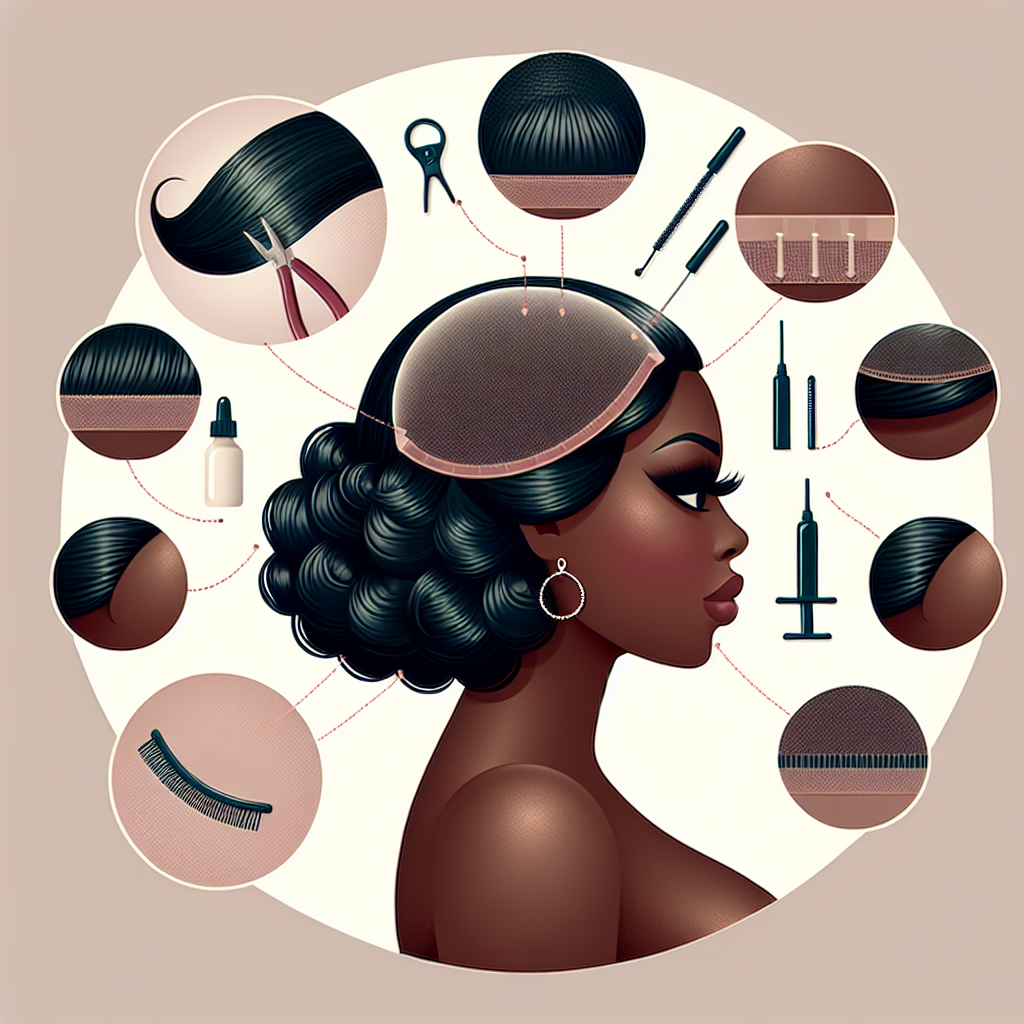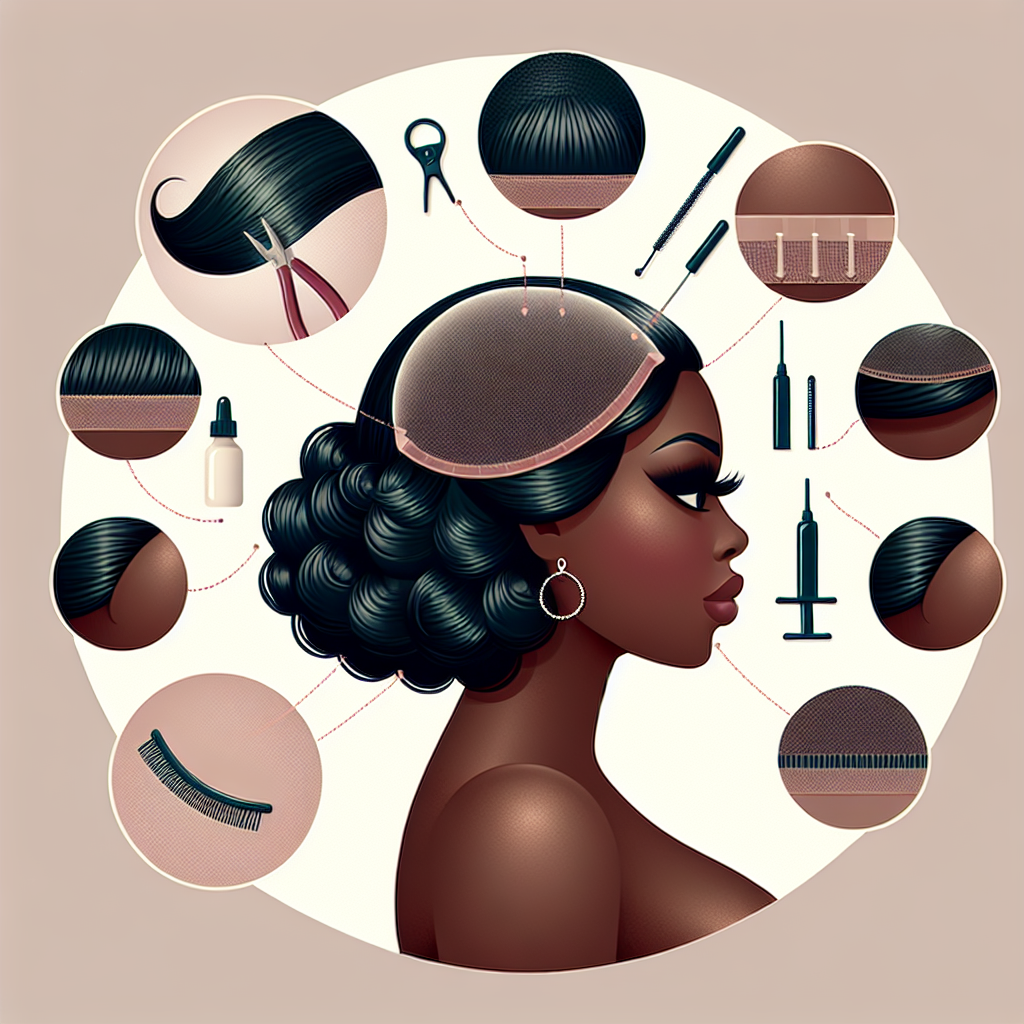Imagine walking into a room with utmost confidence, only to have your wig suddenly slip off and send your self-assurance plummeting. We’ve all been there, which is why we’re here to help. In this article, we’ll reveal five simple yet effective tips that will keep your human hair wig securely in place, saving you from those unexpected embarrassing moments. So, say goodbye to worries and hello to a flawless look that will stay put all day long!
Choosing the Right Wig Cap
Select a Wig Cap with Combs or Clips
When choosing a wig cap, it’s essential to consider one that has combs or clips attached. These combs or clips will help secure the wig in place, preventing it from slipping off during the day. Look for a wig cap that has at least two or three combs or clips strategically placed around the cap. These will provide a secure anchor for your wig and ensure that it stays in place throughout the day.
Consider a Wig Grip or Band
Another excellent option to help keep your wig from slipping off is to use a wig grip or band. Wig grips are made from a soft, stretchy material that fits snugly around your head, creating a secure base for your wig. They work by providing friction between your scalp and the wig, making it less likely to slide around. Alternatively, you can opt for a wig band, which is a wide elastic band that wraps around your hairline. This band helps keep your natural hair and wig in place, providing additional security and stability.
Opt for Adjustable Straps
Adjustable straps are an important feature to consider when selecting a wig cap. These straps allow you to customize the fit of your wig, ensuring that it feels secure and comfortable on your head. By tightening or loosening the straps, you can achieve the perfect fit for your specific head size and shape. Adjustable straps are especially beneficial if you have a smaller or larger head circumference, as they can accommodate a range of sizes. Make sure to choose a wig cap with adjustable straps for a more secure and snug fit.
Preparing Your Natural Hair
Braid or Cornrow Your Hair
Before applying a wig, it’s crucial to prepare your natural hair to ensure a smooth and seamless fit. One of the best ways to do this is by braiding or cornrowing your hair. Creating a base of braids or cornrows will flatten your natural hair, making it easier to apply the wig and prevent any bulges or bumps. Additionally, braiding or cornrowing your hair will provide a secure foundation for the wig to be attached, minimizing the chances of it slipping off.
Use a Wig Cap to Secure Your Hair
Using a wig cap is another important step in preparing your natural hair for wig application. A wig cap acts as a barrier between your natural hair and the wig, helping to keep everything in place. It provides a smooth surface for the wig to sit on, reducing friction and preventing your natural hair from interfering with the wig’s fit. Choose a wig cap that matches your skin tone to create a seamless transition between your scalp and the wig.
Apply a Wig Grip or Band
In addition to using a wig cap, applying a wig grip or band can further secure your natural hair and wig. The wig grip or band will help hold the wig cap in place, preventing it from shifting throughout the day. Simply place the wig grip or band over the wig cap, ensuring that it covers your hairline and sits firmly on your head. This extra layer of security will make your wig feel more stable and less likely to slip off.

Proper Wig Application
Apply Wig Adhesive
For an even more secure hold, you may choose to use wig adhesive. Wig adhesive is a specialized glue that can be applied to the perimeter of the wig cap, creating a strong bond between your scalp and the wig. Before applying the adhesive, make sure your scalp and forehead are clean and free of any oils or residues. Apply a thin layer of the adhesive along your hairline and gently press the wig onto it, starting from the front and working your way back. This will help the wig adhere to your scalp and stay in place.
Use Bobby Pins or Hairpins
Another helpful method to prevent your wig from slipping off is to use bobby pins or hairpins. These small but mighty accessories can be strategically placed to secure the wig in place. Simply slide the pins through the wig cap and into your natural hair, being careful not to tug or pull the hair. By using bobby pins or hairpins, you can create additional anchor points for the wig, ensuring that it stays put throughout the day.
Make Use of Wig Tape
If you prefer a temporary solution, wig tape can be an excellent option. Wig tape is a double-sided adhesive that can be applied directly to the wig cap and your scalp. It provides a strong bond, keeping the wig securely in place. To use wig tape, cut it into small strips and apply them along the perimeter of the wig cap. Gently press the wig onto the tape, starting from the front and working your way back. The tape will keep the wig secure, giving you peace of mind and ensuring it stays in place.
Adjusting the Wig Fit
Tighten Adjustable Straps
If you find that your wig is slipping off, adjusting the straps can help achieve a tighter fit. Most wigs come with adjustable straps at the back, allowing you to customize the tightness to your preference. Locate the straps on the wig cap and pull them to tighten, ensuring that the wig fits securely on your head. Adjusting the straps will create a snugger fit, preventing the wig from shifting or sliding during wear.
Add Wig Clips or Combs
To further enhance the stability of your wig, you can add additional wig clips or combs. Wig clips and combs are small, toothed attachments that can be sewn onto the wig cap, providing extra grip and support. Simply position the wig clips or combs in the desired areas, such as the front, sides, and back of the wig, and sew them securely onto the cap. These clips or combs can then be attached to your natural hair or the wig cap, preventing any unwanted movement.
Customize with Velcro Strips
If you’re looking for a convenient and adjustable solution, velcro strips can be a great option. Velcro strips can be easily attached and detached from the wig cap, allowing you to achieve a customized fit. Simply stick one side of the velcro strip onto the inside of the wig cap and attach the corresponding side to your natural hair or scalp. This will create a secure connection between the wig and your head, ensuring a snug fit and minimizing any slipping or shifting.

Securing the Wig with Accessories
Attach a Wig Grip or Band
To provide an additional layer of security, you can attach a wig grip or band over the top of your wig. This will help hold the wig in place and prevent it from slipping off. Wig grips and bands are designed to fit comfortably around your head, creating a secure base for the wig to sit on. They work by providing friction and grip between your scalp and the wig, ensuring that it stays in place throughout the day.
Try a Wig Grip with Adjustable Straps
If you prefer extra versatility and a personalized fit, consider using a wig grip with adjustable straps. This type of grip combines the benefits of a wig grip and adjustable straps, allowing you to customize the fit according to your head size and shape. The adjustable straps can be tightened or loosened to achieve the desired tightness, while the grip itself provides added security and stability.
Use Wig Glue or Tape
For a more long-lasting hold, you may opt to use wig glue or tape. Wig glue and tape create a strong bond between your scalp and the wig, preventing it from shifting or slipping off. To use wig glue, apply a small amount along the hairline or perimeter of the wig cap and press the wig onto it. For wig tape, cut it into small strips and attach them to the wig cap and your scalp. Both options offer a reliable method of securing your wig for extended periods.
Avoiding Excessive Movement
Avoid Rubbing or Scratching Your Scalp
To maintain the integrity of your wig and prevent it from slipping off, it’s crucial to avoid excessive movement on your scalp. Rubbing or scratching your scalp vigorously can cause the wig to shift or loosen, leading to potential slipping. If you experience itchiness, gently pat or tap the itchy area instead of scratching to minimize movement and ensure that the wig remains secure.
Minimize Touching or Adjusting the Wig Too Often
While it may be tempting to constantly adjust or touch your wig, doing so can increase the likelihood of it slipping off. Each time you touch or adjust the wig, you risk loosening its grip on your scalp. Therefore, it’s best to minimize touching or adjusting the wig throughout the day. Instead, trust in the secure methods you’ve used to secure the wig and allow it to stay in place naturally.
Secure Long Hair with Bobby Pins
If you have long natural hair, it’s important to secure it properly to prevent interference with the wig and potential slipping. Before applying the wig, gather and secure your long hair into a low bun or ponytail. Use bobby pins to anchor the hair and keep it flat against your head. By securing your long hair, you provide a smooth base for the wig to sit on, reducing the chance of it slipping off.
Maintaining a Clean Wig Cap
Cleanse Your Scalp Regularly
To ensure that your wig cap remains clean and free of oils or residues, it’s essential to cleanse your scalp regularly. Cleanse your scalp with a gentle shampoo formulated for wigs, focusing on the hairline and areas where the wig cap sits. Keeping your scalp clean will prevent any buildup or greasiness that may interfere with the wig’s adherence to your head, helping to maintain a secure fit.
Wash the Wig Cap as Recommended
In addition to cleansing your scalp, it’s important to wash the wig cap itself as recommended by the manufacturer. Most wig caps can be hand washed with a mild detergent or wig shampoo. Gently massage the cap to remove any dirt, oils, or sweat that may have accumulated. Rinse thoroughly and allow it to air-dry completely before wearing again. Washing the wig cap will ensure that it remains clean and fresh, providing a comfortable and secure foundation for your wig.
Avoid Excessive Oily Hair Products
Using excessive oily hair products can make the wig cap slippery and prevent it from staying in place. Avoid using heavy oils or greasy styling products on your natural hair when wearing a wig. Opt for lightweight, water-based products instead. These products will help maintain a clean and non-slippery wig cap, ensuring that your wig stays secure throughout the day.
Using Heat Styling Techniques Cautiously
Avoid Exposing the Wig to High Temperatures
Human hair wigs can be styled using heat styling tools, but exposing them to high temperatures can compromise their structure and cause slipping. It’s important to avoid excessive heat when styling your wig, as it can weaken the fibers and loosen the cap’s grip. If you need to use heat styling tools, such as flat irons or curling irons, set them to a lower temperature and use a heat-protective spray to minimize damage and preserve the wig’s fit.
Use Heat-Protective Products
Before applying heat to your wig, it’s crucial to use a heat-protective product. These products create a barrier between the heat and the wig, minimizing any potential damage or alterations to the cap’s grip. Spray a heat-protective product onto the wig before using any heat styling tools to ensure the best protection for both the wig and its fit.
Choose Heat Styling Tools with Adjustable Temperatures
When selecting heat styling tools to use on your wig, opt for tools that have adjustable temperatures. This feature will allow you to control the heat and prevent exposing the wig to high temperatures. Start with a lower temperature setting and gradually increase if necessary. By using heat styling tools with adjustable temperatures, you can safely style your wig without compromising its fit or stability.
Storing the Wig Properly
Store the Wig in a Wig Stand or Mannequin Head
Proper storage is essential to maintain the shape and integrity of your wig. When not in use, store your wig on a wig stand or mannequin head. This will help preserve the wig’s style and prevent it from losing its shape. Place the wig securely on the stand or mannequin head, and arrange the hair to maintain its desired style. Storing the wig in this manner will ensure that it remains in optimal condition and ready to wear without slipping off.
Keep Away from Direct Sunlight or Heat Sources
When storing your wig, it’s vital to keep it away from direct sunlight or any heat sources. Excessive heat can cause the wig cap to become soft and lose its shape, making it more likely to slip off. Choose a storage area that is cool, dry, and away from sunlight to maintain the wig’s integrity and prevent any potential damage or shifting.
Avoid Storing Near Excessive Moisture
Moisture can also be detrimental to the durability and fit of your wig. Avoid storing your wig near excessive moisture, such as in a bathroom or damp basement area. Moisture can cause the cap to warp or lose its shape, compromising the fit and leading to slipping. Instead, choose a dry and well-ventilated storage area to preserve the wig’s condition and ensure a secure fit when worn.
Scheduling Regular Wig Maintenance
Trim or Restyle the Wig as Needed
To keep your wig looking fresh and prevent any alterations that may affect its fit, schedule regular maintenance. Trim or restyle the wig as needed to remove any split ends or maintain the desired style. Regular trimming will help prevent any excess weight that could cause the wig to slip off. Additionally, restyling the wig can help reset any styling techniques that may have loosened over time, ensuring a secure fit when worn.
Consult with a Professional Stylist
If you’re unsure about trimming or restyling your wig yourself, it’s always a good idea to consult with a professional stylist. They have the expertise and knowledge to handle human hair wigs properly, ensuring that any adjustments made do not compromise the cap’s fit. A professional stylist can provide valuable advice and assistance in maintaining the wig’s style and secure fit.
Inspect and Repair Any Loose Components
Regularly inspect your wig for any loose components, such as combs, clips, or adhesive. Over time, these components may become worn or loose, affecting the wig’s fit. If you notice any loose parts, it’s important to repair or replace them promptly. Restoring the wig to its original condition will ensure that it remains secure and prevents any slipping or movement.
In conclusion, keeping a human hair wig from slipping off requires careful preparation, proper application, and regular maintenance. By selecting the right wig cap with combs or clips, using a wig grip or band, and opting for adjustable straps, you can ensure that your wig stays securely in place. Preparing your natural hair by braiding or cornrowing it and using a wig cap are essential steps to achieve a smooth and seamless fit. Properly applying the wig with adhesive, bobby pins or hairpins, and wig tape further enhance its stability. Adjusting the wig fit by tightening adjustable straps, adding wig clips or combs, and customizing with velcro strips can help achieve a snug and secure fit. Securing the wig with accessories such as a wig grip or band, a wig grip with adjustable straps, or wig glue or tape provides additional layers of support. Avoiding excessive movement, maintaining a clean wig cap, using heat styling techniques cautiously, storing the wig properly, and scheduling regular maintenance are all crucial factors in preventing a human hair wig from slipping off. By following these tips and techniques, you can enjoy a comfortable and secure fit with your human hair wig all day long.
